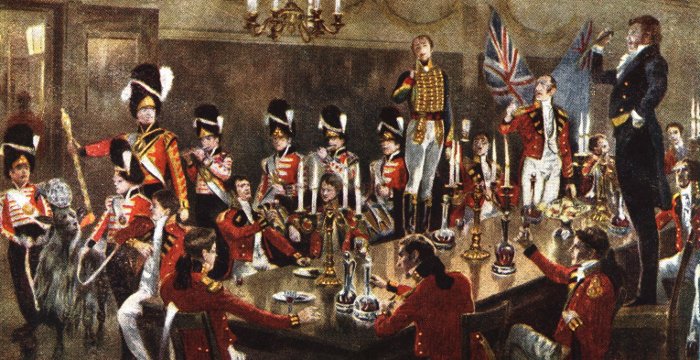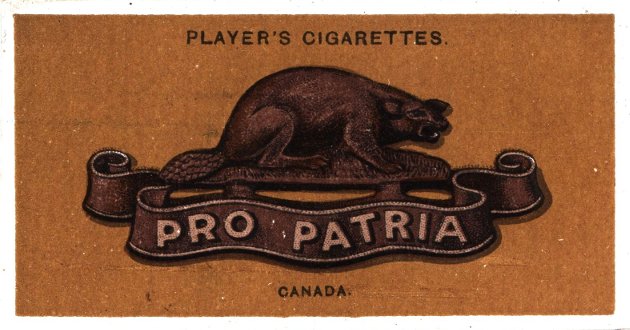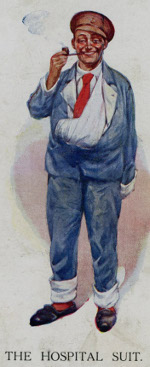The Formation of the 7th Canadian Infantry Brigade; CEF
Topic: CEF

Extracts from the opening pages of the War Dairy of the 7th Canadian Infantry Brigade. The 7th Canadian Infantry Brigade was formed in France on the 22nd December, 1915. The units comprising the Brigade being:-
Lieut. Colonel A.C. Macdonell, D.S.O. Officer Commanding Lord Strathcona's Horse (Royal Canadians) was appointed Brigade Commander with the temporary rank of Brigadier General, and took over the Command of the 7th Brigade on the 22nd December, 1915. General Macdonell has seen considerable fighting, being present at the actions at Festubert, Givenchy, and Cuinchy besides which he had previously seen active service in the South African War, in Command of Canadian Mounted Rifles.
 THE ROYAL CANADIAN REGIMENT
THE ROYAL CANADIAN REGIMENT
The Royal Canadian Regiment was raised as a unit of the Canadian Permanent Force in December 1883 under the name of the Infantry School Corps, being raised primarily for the purpose of instructing the Canadian Militia, but its establishment being increased it took over the garrisoning of places occupied by Imperial Troops. A detachment took part in the Expedition in North West Canada, 1884-1885, and bears that honour, and Saskatchewan, in 1899 2nd Battalion was raised for service in the South African War 1899-1900 and was present at the battle of Paardeberg. A 3rd Battalion was raised to garrison Halifax, Canada. Both these Battalions were disbanded after the South African War.
The Regiment bears the Badge of the Imperial Cypher V.R.I. and Imperial Crown granted by Her Majesty Queen Victoria in 1894. On the outbreak of the European war the Regiment was mobilized at Halifax, Nova Scotia and occupied the defences at that station, with detachments at defensive points throughout Nova Scotia.
Having been brought up to War strength by recruits from the Canadian Expeditionary Force Camp at Valcatier P.Q. the Regiment sailed for Bermuda on September 10th 1914 And relieved the 2nd Battalion Lincolnshire Regiment. On being relieved by the 38th Battalion Canadian Overseas Expeditionary Force it proceeded to England via Halifax leaving Bermuda on August 13th 1915, arriving in England September 5th 1915. It was rearmed and equipped at Shorncliffe, casualties being filled by drafts from Canada and volunteers from the other Canadian Battalions at Shorncliffe. The Regiment landed in France on November 1st and proceeded to Bailleul, being billeted around Meteren and forming part of Corps troops of the Canadian Corps. A week later it moved to Westhof and went into the trenches for instruction in trench warfare with the 2nd Canadian Infantry Brigade at Ploegstreert [Ploegsteert] The Regiment then moved to LaClytte – 2nd Canadian Divisional Area – on November 19th where after supplying working parties for front line trenches and supports for about a month it moved to Boeschepe and became part of the 7th Canadian Infantry Brigade on the 22nd December 1915.
 PRINCESS PATRICIA'S CANADIAN LIGHT INFANTRY.
PRINCESS PATRICIA'S CANADIAN LIGHT INFANTRY. Among the many Regiments serving in France and elsewhere on the side of the Allies few have been inaugurated under more favourable auspices than The Princess Patricia's Canadian Light Infantry. Owing to the untiring energy and generosity of Major A. Hamilton Gault, D.S.O., authority was granted, one week after the war was declared, to raise one Battalion to form part of the Canadian Expeditionary Force. To facilitate recruiting depots were established at Montreal, Toronto, Winnipeg, Manitoba, Calgary and Edmonton Alberta. In each of these cities prominent citizens were invited to collect recruits, besides which notices were inserted in various Canadian Newspapers, calling for recruits and stating terms of enlistment.
Lieut. Colonel Farquhar D.S.O. Coldstream Guards was given command, and Headquarters were established in the city of Ottawa, the Capitol of the Dominion of Canada. Recruiting commenced on the 12th of August 1914, and by the 26th August the Regiment was up to strength, fully equipped and ready to proceed overseas. One of the conditions of enlistment was that every recruit have previously belonged to some regiment of the British Army, and it is interesting to note that 50% of the recruits had previously seen active service, and that every regiment of the British Army was represented, with the exception of the Inniskilling Dragoons.
The Battalion sailed from Quebec on September 28th, 1914 …[overseas, it] joined the 27th Division, being Brigaded with the 2nd Battalion Kings Own Shropshire Light Infantry, 3rd and 4th Battalions Kings Royal Rifles, Corps, and 4th Battalion Rifle Brigade, to form the 80th Brigade.
Arriving in France on the 22nd December, 1914, … the Battalion was engaged in trench warfare taking part in an attack on the German sap near Shelby Farm on the 28th February 1915, (where Where Major A Hamilton Gault was wounded) and the counter attack at St. Eloi on the 15th March 1915. On March 21st 1915 Lieut. Colonel H.D. Farquhar was killed and Lieut Colonel H.C. Buller, Rifle Brigade took Command of the Battalion. On the 5th April 1915 The Battalion took over the trenches in Polygon Woods and remained in the Ypres Salient, without being relieved, until the 3rd May – 25 days – when they moved to the Bellewarde [Bellewaerde] Line. On the 4th May there was a heavy bombardment of this line by the enemy and 25 men were killed and 96 wounded, they were relieved here during the night by the 2nd K.S.L.I. and held the G.H.Q. line at Ypres. Lieut Colonel H.C. Buller being wounded during the shelling of that place on the following day the 5th May 1915, when the Germans made a general attack. Princess Patricias Canadian Light Infantry losing 16 Officers and 450 other ranks, killed and wounded, during the engagement. On being relieved from the first line trenches on the 9th May 1915 they formed a composite Battalion with the 4th K.R.R.C. and took part in the counter attack at Hooge on the 24th May 1915, when they again had a heavy casualty list. On the 28th May 1915 the 80th Brigade moved to the Armentieres District and relieved the 6th Division at L'Epignette, and the Battalion remained in that vicinity until 14th September 1915, when the Brigade took over an area in the Somme District where they remained until the 25th October 1915, during part of this period the Battalion was in the trenches continuously for 23 days. leaving the 8th Brigade, 27th Division on 9th November, 1915 The Battalion was attached as Instructional Battalion to the 3rd Army School of Instruction until the 25th November 1915, when it entrained for Castre and joined the Canadian Expeditionary Force, becoming part of the 7th Canadian Infantry Brigade on the 23rd December 1915.
 42ND BATTALION, (5TH ROYAL HIGHLANDERS OF CANADA).
42ND BATTALION, (5TH ROYAL HIGHLANDERS OF CANADA).
42nd Battalion (5th Royal Highlanders of Canada) Canadian Expeditionary Forces (Lieut Colonel G.C. Cantlie) joined the Brigade on its formation at Mont-des-Cats, having been for a period of nearly three months on Active Service in France. Recruited and mobilized in the City of Montreal, Province of Quebec in February 1915, and after five months training in Canada sailed for England, where further training in musketry was undergone until the 9th October 1915 when the Battalion came over to France.
The 42nd Canadian Infantry Battalion is now perpetuated by The Black Watch of Canada (Royal Highland Regiment).
 49th BATTALION (CANADIANS).
49th BATTALION (CANADIANS).
The 49th Battalion (Lieut Colonel W.A. Griesbach) mobilized in Edmonton, Alberta, the majority of the members of the Battalion being railway men, miners and farmers – about 35% being Canadian and the remainder British born, and recruited from the Northern portion of the Province, from Edmonton Peace River District and the vast territory north and west of the Capital City of the Province, a large percentage of the men being of Scotch descent.
The 49th Canadian Infantry Battalion is now perpetuated by The Loyal Edmonton Regiment (3rd Bn, Princess Patricia's Canadian Light Infantry).
The Brigade being composed as it is of well disciplined and seasoned troops there seems no reason why it should not be able in a short while to hold its own with the other Brigades of the Canadian Expeditionary Forces. All feel that the good opinion already formed after a careful inspection of the units, will not be misplaced, and that when the records of this campaigns are written, the 7th Canadian Infantry Brigade, will not have failed to carry out its duties in a sound soldierly manner.

Posted by regimentalrogue
at 12:01 AM EDT




 THE ROYAL CANADIAN REGIMENT
THE ROYAL CANADIAN REGIMENT PRINCESS PATRICIA'S CANADIAN LIGHT INFANTRY.
PRINCESS PATRICIA'S CANADIAN LIGHT INFANTRY.  42ND BATTALION, (5TH ROYAL HIGHLANDERS OF CANADA).
42ND BATTALION, (5TH ROYAL HIGHLANDERS OF CANADA). 49th BATTALION (CANADIANS).
49th BATTALION (CANADIANS).

 The RCR would serve in France and Flanders from November 1915 until the end of the War and approximately 4800 Canadians would wear the Regiment's
The RCR would serve in France and Flanders from November 1915 until the end of the War and approximately 4800 Canadians would wear the Regiment's 



 On
On 


 Many old soldiers like to talk about the "good old days" when, in their hazy remembrance, soldiers were more disciplined, less likely to question any aspect of military life, and worked and played harder. While the achievements of the Canadian Army in
Many old soldiers like to talk about the "good old days" when, in their hazy remembrance, soldiers were more disciplined, less likely to question any aspect of military life, and worked and played harder. While the achievements of the Canadian Army in 
 The first medal that many Canadian soldiers might have been eligible to receive for their First World War service was the
The first medal that many Canadian soldiers might have been eligible to receive for their First World War service was the 

 Instead, we find that widespread service was made of the British Amy's existing solution for clothing recuperating solders, the "hospital blues." Blue linen suits, lined in white and nattily accessorized with a bright red tie. What self-respecting soldier wouldn't find that outfit stylish and debonair for "walking out" during his convalescence, especially since they came in a range of few sizes fitting few soldiers well. Although originally cut to be buttoned to the neck, turning down the collar of the jacket added the benefit of bright white lapels to the hospital blues' appeal.
Instead, we find that widespread service was made of the British Amy's existing solution for clothing recuperating solders, the "hospital blues." Blue linen suits, lined in white and nattily accessorized with a bright red tie. What self-respecting soldier wouldn't find that outfit stylish and debonair for "walking out" during his convalescence, especially since they came in a range of few sizes fitting few soldiers well. Although originally cut to be buttoned to the neck, turning down the collar of the jacket added the benefit of bright white lapels to the hospital blues' appeal. (Or: "How One Regiment Could be Fighting in Three Places at Once")
(Or: "How One Regiment Could be Fighting in Three Places at Once") The Guide: A Manual for the Canadian Militia (Infantry)
The Guide: A Manual for the Canadian Militia (Infantry)




 Equipment
Equipment



 We often hear catchphrases but we can never quite be certain where they originated. Infantry officers training in the Canadian Army have long head one which goes "Time spent on recce (i.e, reconnaissance) is never wasted" … intending to teach the new officer that even if he or she thinks they understand a situation completely, a thorough reconnaissance (time permitting) is invaluable, if for no other reason to confirm what is known. Inevitably, in training and service afterwards, reconnaissance often identified factors that were previously not known to the officer and which materially affect the plan evolving in their mind. failing to heed this adage can have serious consequences.
We often hear catchphrases but we can never quite be certain where they originated. Infantry officers training in the Canadian Army have long head one which goes "Time spent on recce (i.e, reconnaissance) is never wasted" … intending to teach the new officer that even if he or she thinks they understand a situation completely, a thorough reconnaissance (time permitting) is invaluable, if for no other reason to confirm what is known. Inevitably, in training and service afterwards, reconnaissance often identified factors that were previously not known to the officer and which materially affect the plan evolving in their mind. failing to heed this adage can have serious consequences.


 Not all Battle Honours are equal in terms of the scale of action for which they were awarded. Some cover vast expanses of terrain and months or years of warfare, while others are defined by single dates and very restrictive geographical boundaries. When we look at the list of honours awarded to a regiment we may find Battle Honours that range from Theatre Honours to Separate Actions or Engagements.
Not all Battle Honours are equal in terms of the scale of action for which they were awarded. Some cover vast expanses of terrain and months or years of warfare, while others are defined by single dates and very restrictive geographical boundaries. When we look at the list of honours awarded to a regiment we may find Battle Honours that range from Theatre Honours to Separate Actions or Engagements.
